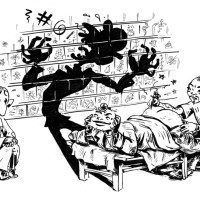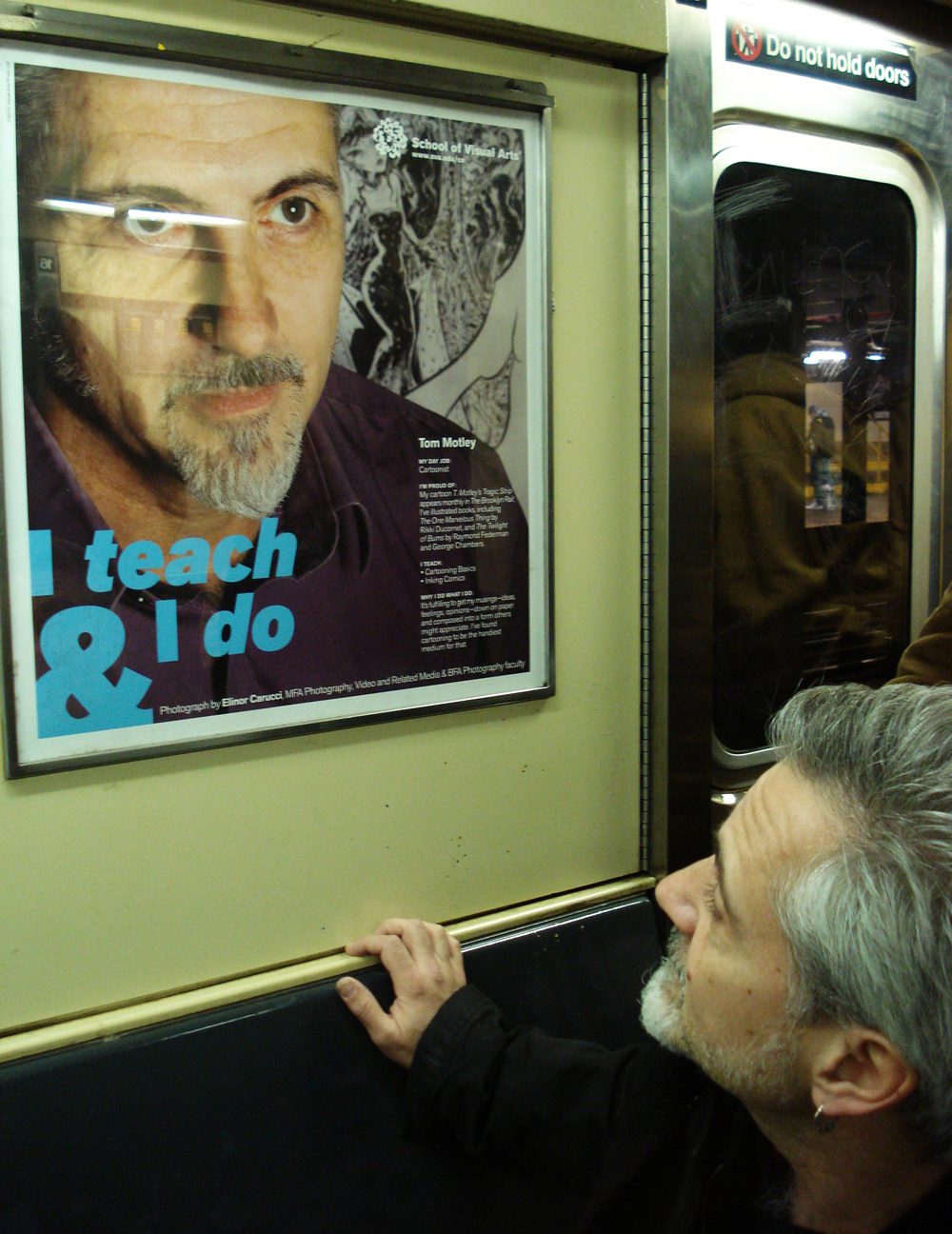The New York Comics & Picture-Story Symposium is a weekly forum for discussing the tradition and future of text/image work. Open to the public, it meets Tuesday nights from 7 to 9 PM EST in New York City. Presentations vary weekly and include everything from historical topics and technical demonstrations to creators presenting their work. Check out upcoming meetings here.
Tom Motley is a cartoonist, illustrator, and educator who’s also been a longtime member of the NY Comics Symposium. His publications include Tragic Strip (a monthly strip in The Brooklyn Rail), The Golden Ass, One Marvelous Thing, The Twilight of the Bums, and many contributions to the indie anthology Cartozia Tales. He also teaches cartooning at the School of Visual Arts and illustration at Pratt. In the 1990s, he oversaw the comic-book collective Hector, “placing jam strips and experimental comics in zines, UG papers, and literary mags” in the U.S. and abroad.* You can see his life drawings and sketches on his sketchblog.
The Rumpus: I know you lived in Denver for many years before coming to New York. Can you talk about the comics scene there, as well as your introduction to the form? How did you encounter comics early on?
Motley: I’m a Denver native. I was there, toiling in obscurity, for almost the first fifty years of my life. I was always a comics fan. My dad kept his collection of comics from the ’40s and ’50s and I bought new stuff with my allowance. I sampled everything, and of course the cream rose to the top. Favorites included Jack Cole, Carl Barks, and Harvey Kurtzman, along with lesser-known great stuff like Klaus Nordling’s The Barker. We got Mad every month, so I was influenced by Aragones, Don Martin, Jack Davis, et al. I loved Archie and Millie the Model as much as Justice League and The Brave and the Bold. In my early teens, I discovered undergrounds and went wild for them, especially R. Crumb and The Freak Brothers by Gilbert Shelton. Then National Lampoon came along with Cheech Wizard, Ed Subitzky’s proto-Oubapoan porno comics, and so much great stuff.

My favorite new comic coming out as a kid was Not Brand Ecch. When I took up drawing in eighth grade, I began by copying Marie Severin panels from there. She had learned her craft, really well, from working on Mad comics at EC. Other images I remember copying were Bernie Wrightson’s Swamp Thing, John Buscema’s Mephisto from Silver Surfer, and Mike Ploog’s Werewolf By Night. The first comic that made me think, That is so fucking cool, I have to devote my life to making something like this was probably Ploog’s Ghost Rider. I still say that when I see something really impressive, most recently, probably, when I discovered the romance comics Matt Baker did for Archer St. John. Any page by Alex Toth can make that feeling well up in me.
I think I had the notion that if I were to memorize the three lines that shade a deltoid, say, and the three for a bicep, etc., I’d know how to draw a figure. I’ll bet a lot of young artists start out thinking that. I was pretty sure drawing was something one could learn, and I wasn’t wrong about that.
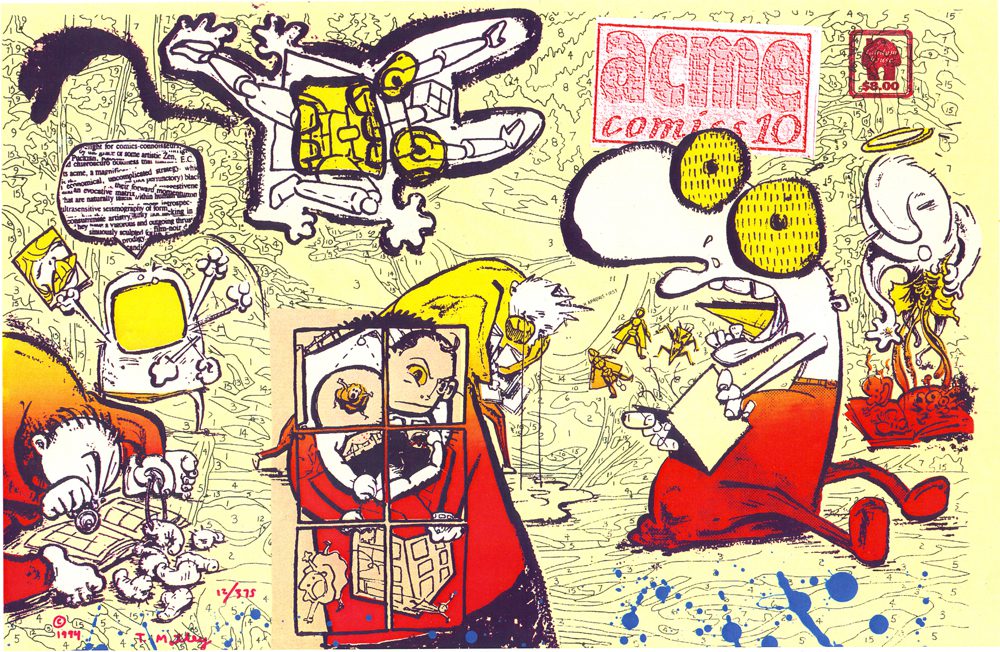
Rumpus: How did you start making comics yourself?
Motley: When I was at art school in St. Louis (Washington University), a chance encounter with Matt Feazell won me over to the DIY approach. So I returned to my parents’ basement upon graduating and commenced to make comics under an assumption of complete creative freedom. Through a local fanzine, Fantasian, I made friends with other wannabe cartoonists and eventually convinced them to start an anthology. We called it Acme Comics and put out ten issues over a bit more than a decade, along with other projects, and held monthly meetings, group critiques, and stuff like that. The other guys (there weren’t many girls interested in comics back then) were oriented toward making superhero fanfic at first, while I tried to get them to read Raw and Weirdo… Looking back, I think some of the tensions within the group reflected tensions within my own feelings about the medium. By the mid 1990s, we changed the group’s name to The Squid Works. I believe they still meet every month, though the original people aren’t involved.

Rumpus: Your work is so full of movement and detail, yet you balance all of that activity with a strong sense of clarity. Can you talk about how you achieve that, and particularly how you compose your pieces? I’m thinking of something like the Yeats quote one.
Motley: Thank you for that.
After years of beating my head against the wall, comparing the good days to the bad ones, I finally figured out that composition is the key to the whole deal—seeing the picture as an interlocking configuration of positive and negative shapes, distorting figures and forms to make the configurations stronger, treating negative spaces as frames for pictures within the picture. If you can control that, you can cram your picture with story information without junking it up.
And the other key is gesture. My favorite comics are the ones bursting with life, like Krazy Kat and Cole’s Plastic Man.
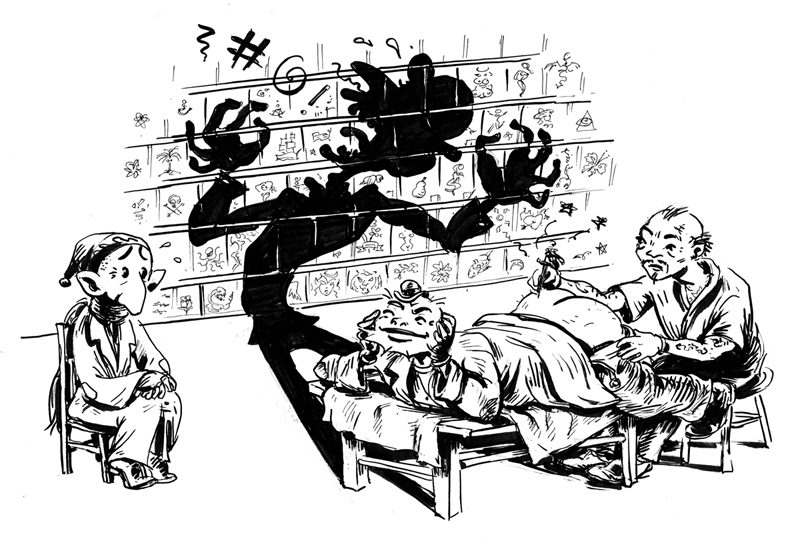
Rumpus: You make great use of constraints in your work, and I know you’re an Oubapo enthusiast. How did you discover Oubapo, and how much do constraints continue to inform your practice?
Motley: From the influence of the undergrounds and the drugs I took in my teens, I was always inclined toward experimental approaches to my comics. At Wash U, I found a course taught by Emma Kafalenos on postmodern experimental fiction. She introduced me to the work of Robbe-Grillet, Sollers, Calvino, Raymond Federman, and others. Later, I discovered Queneau, Roussel, Perec, Borges, Beckett, …
Federman’s seminal essay, “Surfiction,” was a huge influence on my thinking about comics’ potential. I eventually met and collaborated with Raymond, which was very gratifying.
So I was primed and ready when I discovered Warren Motte’s Oulipo: A Primer of Potential Literature around 1990. I immediately started making comics based on the ideas in there. When I met Rikki Ducornet around that time, that was the first thing we talked about. Some years later, Rikki got me admitted to a workshop at DU conducted by Harry Mathews. It was Mathews who told me about Oubapo.
Like most writers and artists who work with constraints, I employ them some of the time, along with the other ideas I play around with, as part of a more general commitment to formalism. My feeling is that concentrating at first on formal problems helps me circumvent the more obvious ideas and surface sentiments, in order to reconnect with my passions and convictions on a deeper level.


Rumpus: You’ve been posting your gorgeous on-location drawings to Your Daily Doodle and Your Daily Sketch for a while now. Can you talk about the role of life drawing in your practice? Are you thinking about collecting that work into any sort of larger project?
Motley: Thanks again. I owe my commitment to sketching to Gil Kane. I took a couple of workshops he taught in the 1980s, sponsored at comic conventions by Fantagraphics Books. He stressed that it’s the hand that learns to draw. The study of art involves clocking the hours training one’s hand. I took his advice and my work finally blossomed.
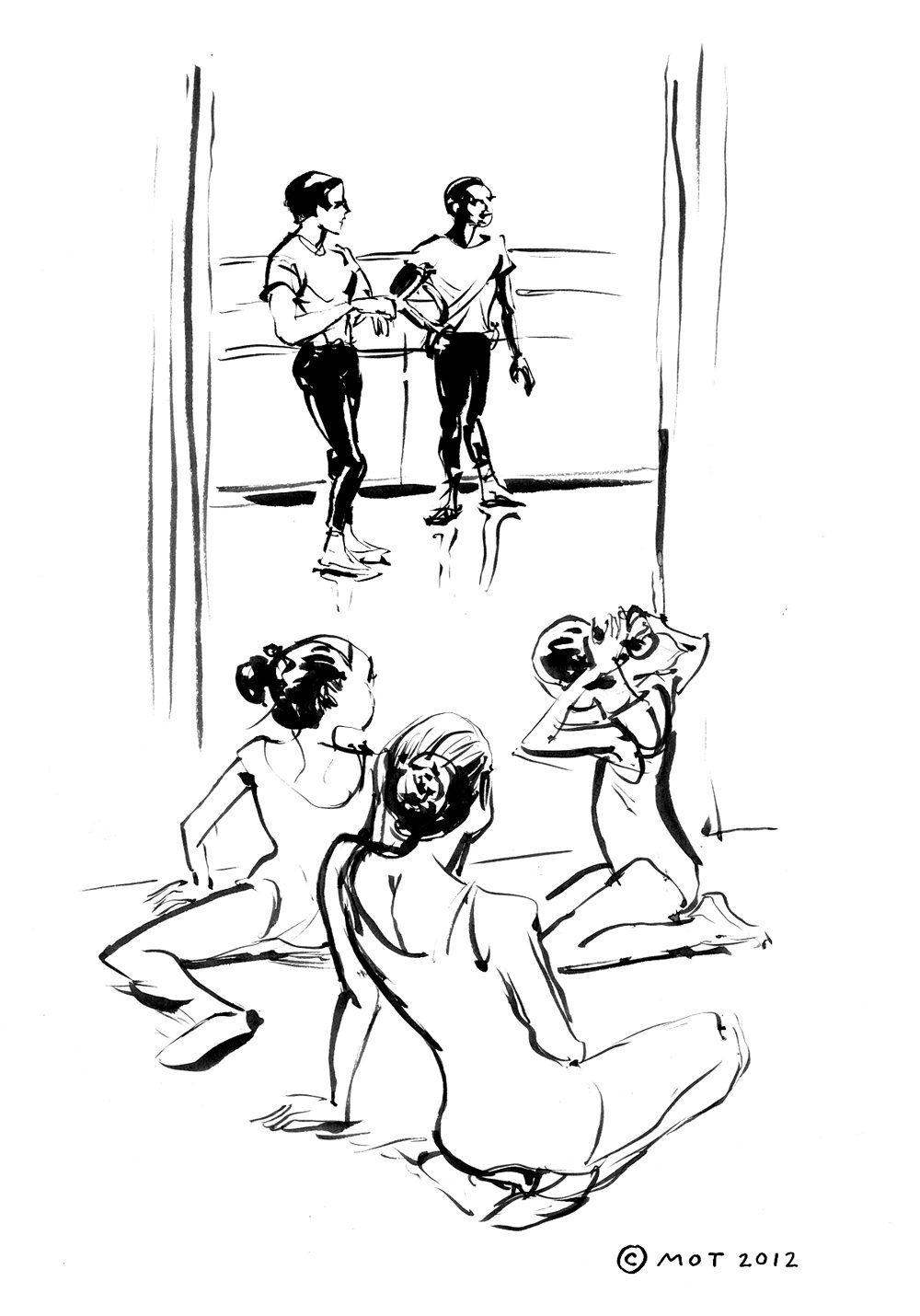
The doodles are the opposite approach of formalism, more like surrealist automatic drawing. They’re an equally productive source for ideas and techniques, as well as a way to interrogate my psyche.
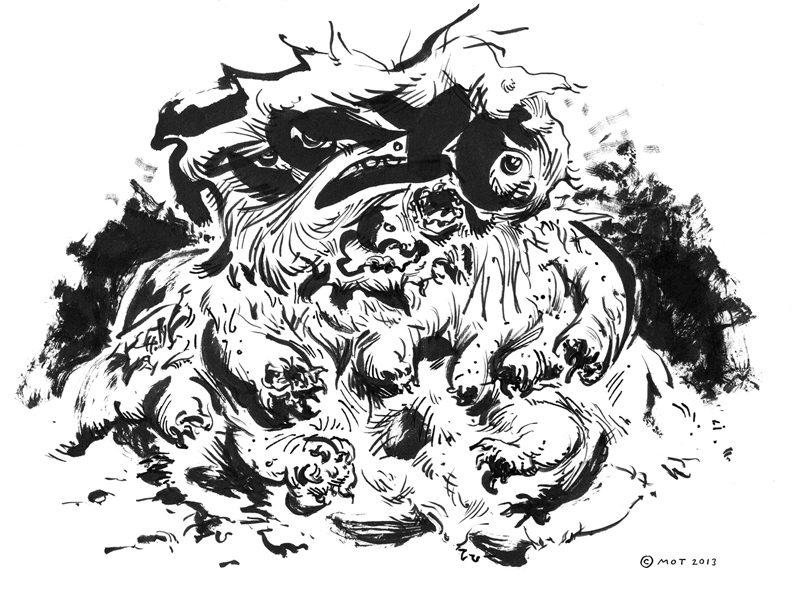
I’d love to collect the best of that stuff, but there hasn’t been much interest in it as far as I can tell. Folks, please scroll through the archives for a fun eye-blast (provided you don’t mind the occasional naked lady picture):
http://yourdailydoodle.tumblr.com/archive
http://yourdailysketch.tumblr.com/archive
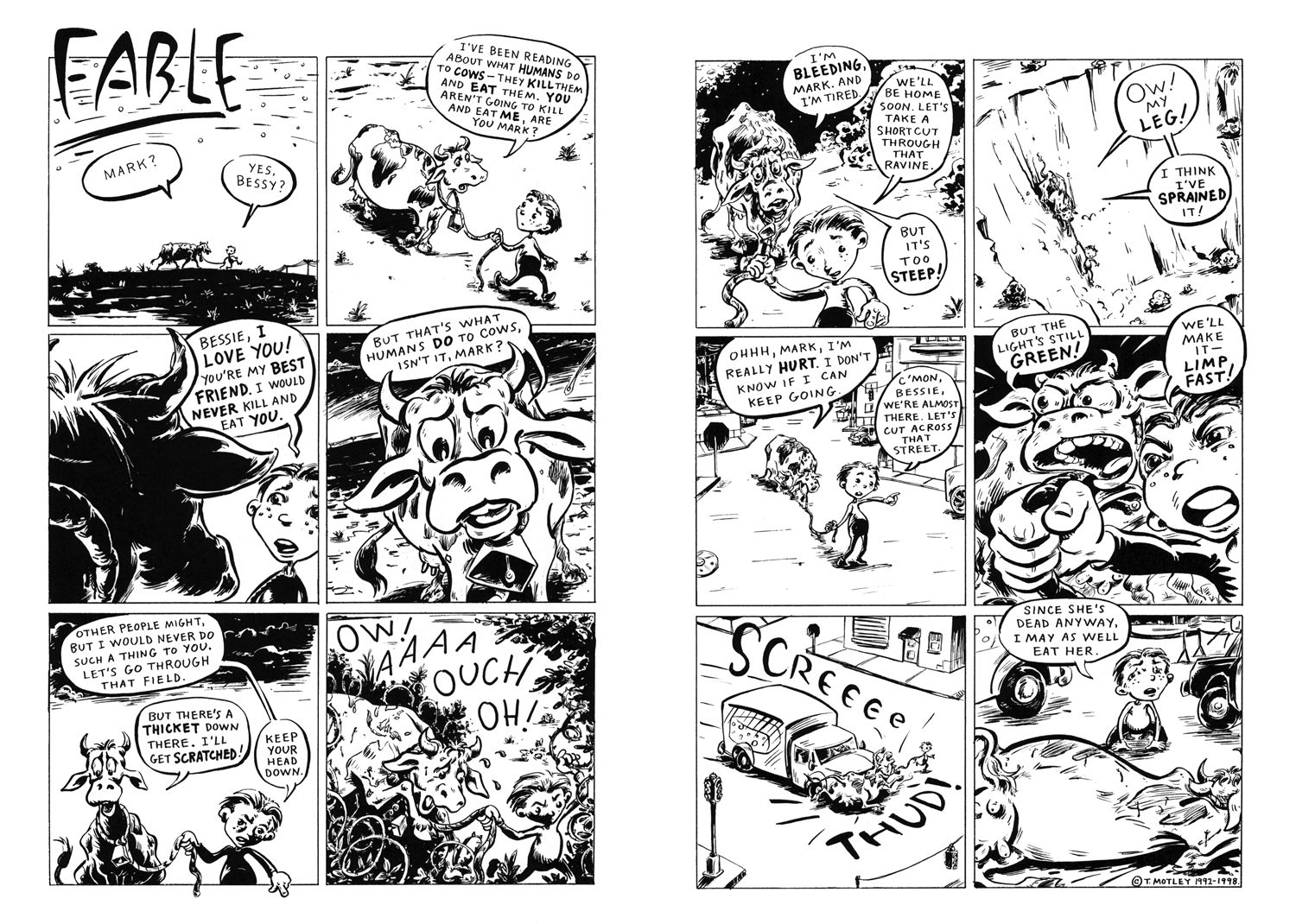
Rumpus: Your work is very funny and your stories also showcase characters caught in situations beyond their control. Can you talk about your approach to humor and what kind of stories you’re drawn to telling?
Motley: I’ll tackle those in reverse order.
I’ve decided my favorite recurring theme involves showing the mechanisms whereby we justify doing unspeakable things to one another. I’m not very conscious of having a sense of humor, only a sense of justice, whose flip side, I think, is irony.
That said, there’s an element of craft involved in setting up surprises and presenting ideas with comic timing that I always hope will draw a laugh from somebody.
May I add that one thing I like to do in my comics is hide little Easter eggs, allusions, and subordinate gags? I’m not sure anyone has noticed.
Rumpus: Following on the last several questions, what inspires you? Both in terms of comics, but also other media, etc.
Motley: I draw a lot of inspiration from literature and criticism (Northrop Frye is a favorite), but also music. My favorite songwriter is also my favorite living cartoonist: Peter Blegvad. My favorite instrumental music is by a Frenchman, Christophe Petchanatz, who issues songs under the name Klimperei, overdubbing toy instruments with melodicas, guitars, and more. When the Swedish accordionist/composer, Lars Hollmer, passed away a few years back, I was devastated. Still am. [Click here for Motley’s gallery of favorite musicians.]
And there are all those fine artists and illustrators: Goya, Grosz, Picasso, Durer, Brueghel, Duchamp, Blake, Kley, Grandville, Tenniel, Posada…We all have our favorites, right?
More cartoonists I care about: Eisner, Elder, Wolverton, Wood, Kirby, Moscoso, Pinsent, Brown, Boswell…the list goes on and on.
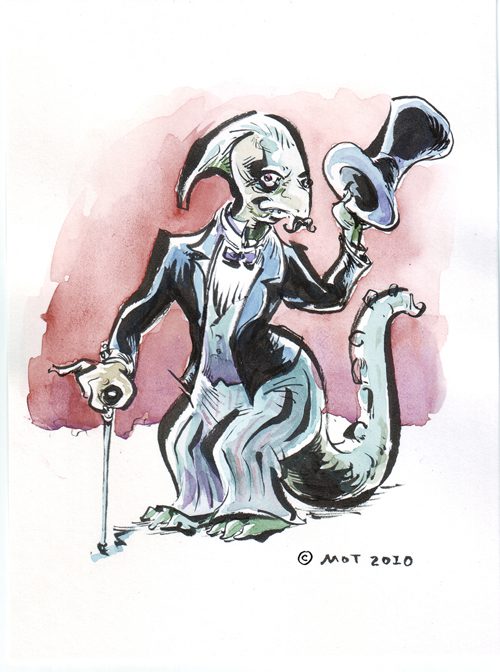
Rumpus: You work almost exclusively in black and white, but you have some beautiful, atmospheric watercolors up on your sketch blogs. Is the palette force of habit, or a more particular choice?
Motley: It’s from decades of having only cheap printing available, photocopy in particular. If I ever knew anything about painting, I fear I’ve forgotten. If you’ve liked any of my attempts at color, I’m immensely relieved. I’ll try to use color more, now that it’s not impractical.
Rumpus: Could you talk about the teaching that you do at SVA?
Motley: Ever since college, I’ve had a strong urge to share the things I learn and figure out. Maybe I’m wired that way and/or maybe I’m inspired by some of the great teachers I had along the way (Barry Schachtman, who taught figure structure at Wash U, especially). In Denver, I started by teaching at Colorado Free University and went on to conduct bunches of kids’ after-school classes and summer camps. One highlight before I moved away was a weekly stint teaching cartooning to inmates at Arapahoe County Jail.
Thanks to my Oubapo-America friends (Matt Madden, Jason Little, Tom Hart, and Jessica Abel), I’ve been teaching at SVA, mostly in continuing ed. I’m also in the illustration department at Pratt Manhattan, in an associate’s-degree program, and I do some after school classes in Brooklyn.
My cartooning-basics course at SVA is an in-depth, adult version of the minicomic-making course I developed for children. I teach an elective for undergrads called “Short-Form Comics,” where I get them to try some of the experimental approaches discussed above. My continuing-ed Figure Drawing for Cartoonists is enrolling right now. It stresses those problems of movement and clarity you mentioned. Come sign up!

Rumpus: You’re working on a really cool, slightly Oubapo-esque project right now: Cartozia Tales. Can you tell us about how you hooked up with the project, how exactly the collaboration works, where it might be going?
Motley: Cartozia Tales is the brainchild of Isaac Cates, with whom I’ve collaborated over the years and even tabled with at MoCCA. It’s about a fantasy world a group of us created by starting with a map, filling it with place names, and populating it with creatures and characters. The map is divided into nine sectors. Each issue, the sectors are randomly assigned to the core contributors and celebrity guests to set stories within. We find ourselves continuing stories begun by other players.
Isaac recruited a core group of brilliant young cartoonists to do this, plus me. I think the others were chosen for having talent with kids’ comics and the fantasy genre. I’m there for my love of creative games. I’m a bit of an odd duck, but my quirkiness should enrich the project long-term.
The thing I never anticipated about this project is how incredibly fun it is to work on. If it’s a tenth as fun to read as it is to make, it should be pretty entertaining. Watching these storylines develop without knowing which will be yours to continue, you find yourself fantasizing about all of them. Then seeing the whole thing morph as the game unfolds is pretty delightful. The public response surrounding the Kickstarter campaign was really enthusiastic. I believe we’re pioneering a model for an approach to game-based comic anthologies that will be repeated with varying rules and structures by many more publishers. A lot of the cartoonists I talk to seem to want to take part in this. Maybe Isaac will get a genius grant someday.
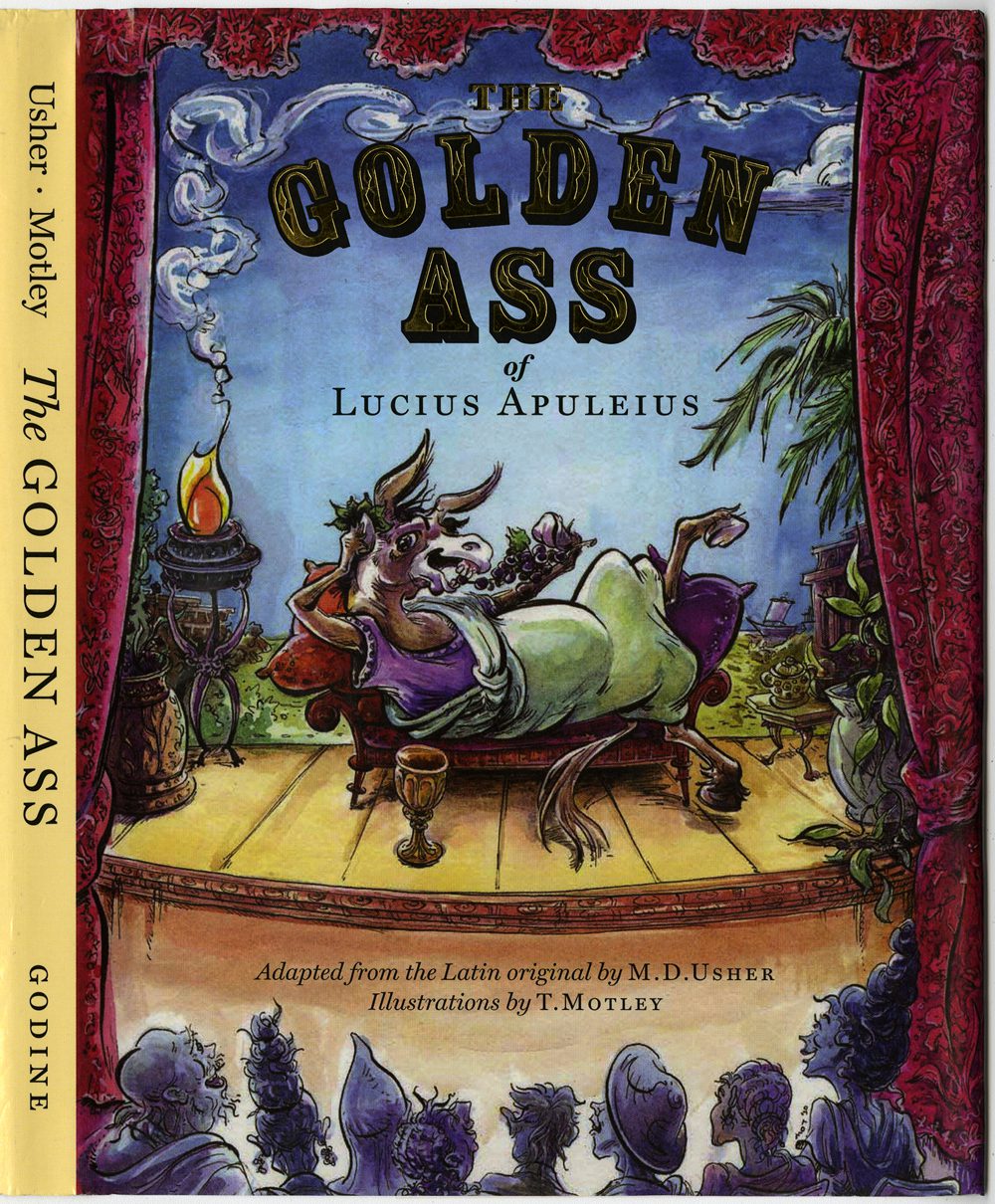
Rumpus: Can you talk about illustrating The Golden Ass?
Motley: Isaac Cates is also a poetry professor at the University of Vermont, and he put me in touch with one of their classics professors, Mark Usher, who was working on a version of Apuleius’s classic for young readers. I signed on when I learned it was to be published by David R. Godine, whose catalog I admire (he put out some of Perec’s great work in English).
The Golden Ass exerted a strong influence on western literature. We find echoes of it in Don Quixote, A Midsummer Night’s Dream, Pinocchio, and more. I used the illustrations to hint at that, and to support the reading with decorated initials and silhouette dingbats to open and close each chapter. I like to try to give illustrations some job to do because, as we know, they aren’t needed.
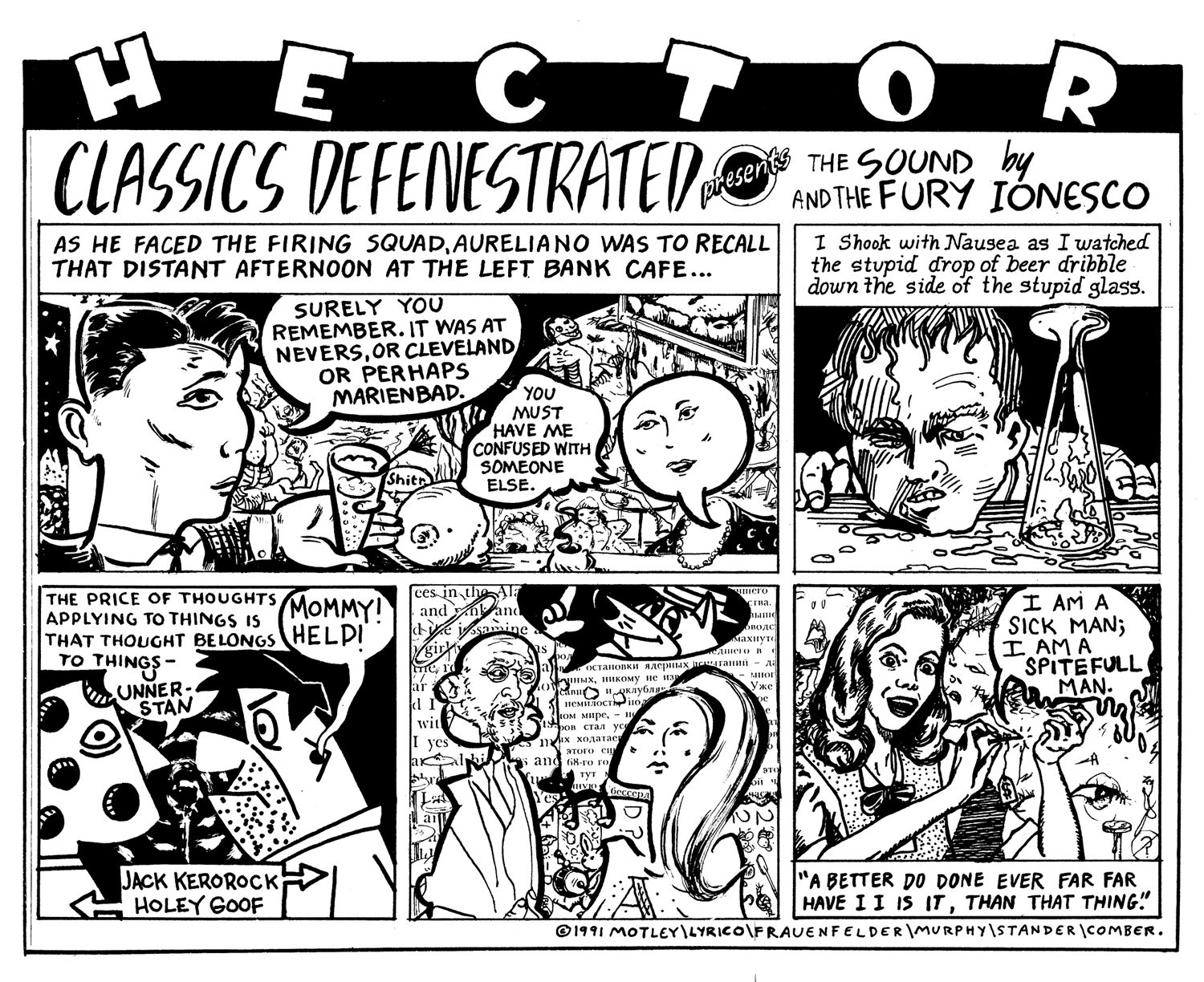
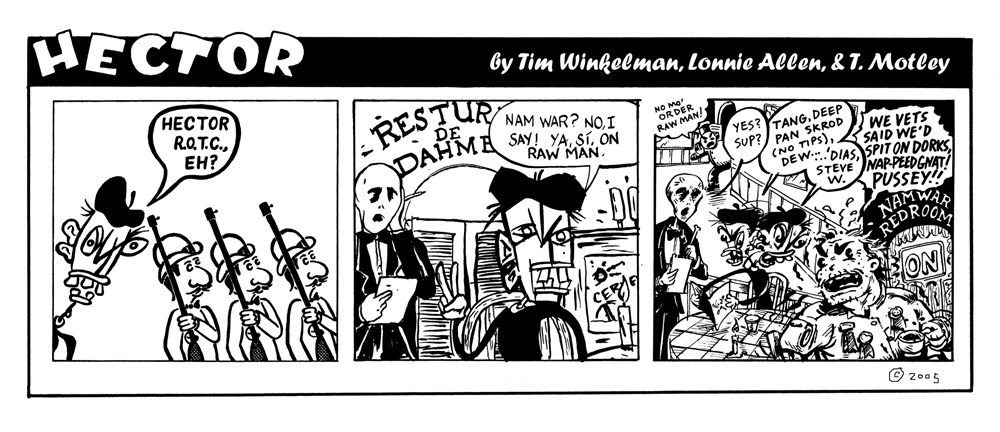
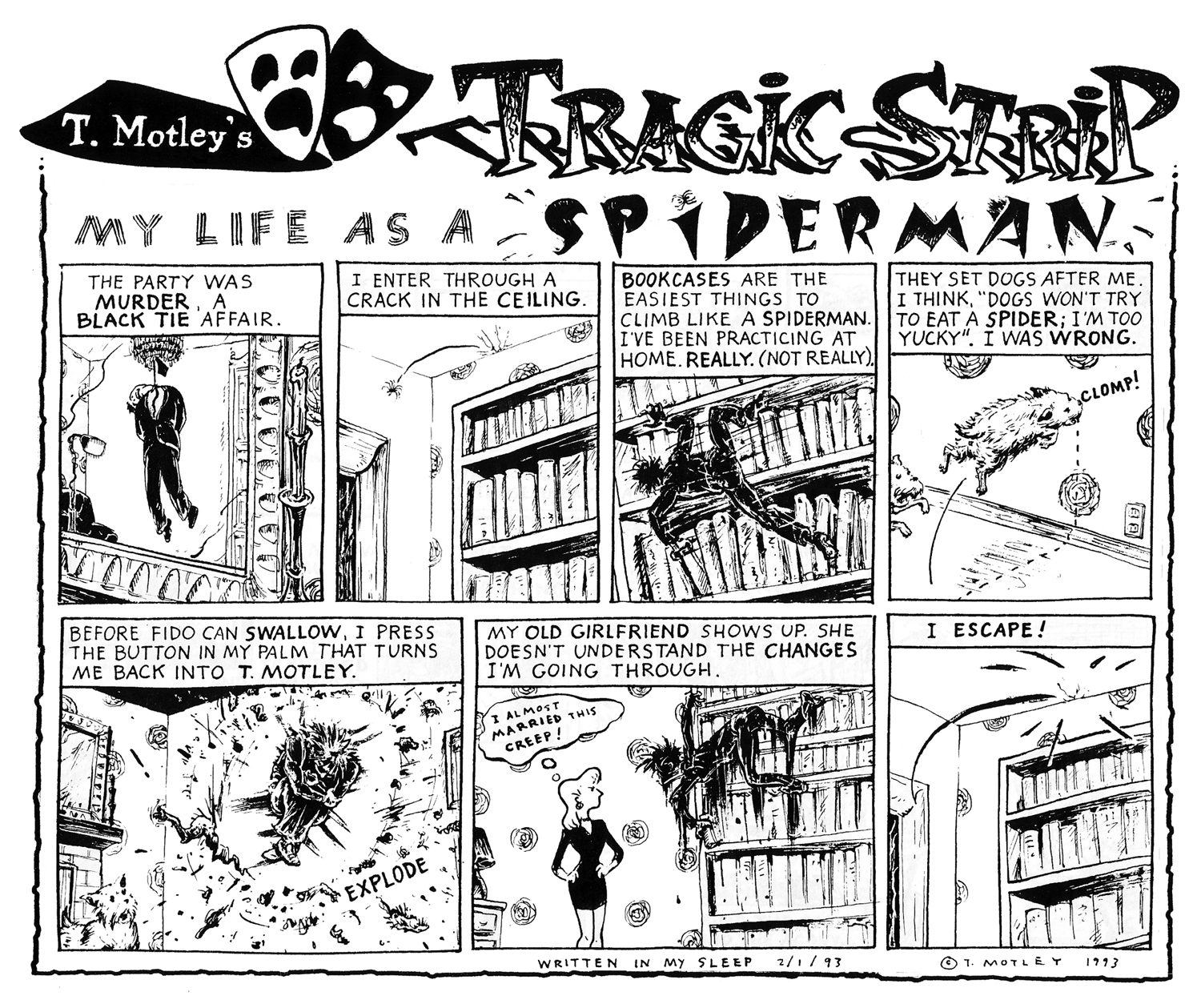
Rumpus: You use Tragic Strip, your comic strip in the Brooklyn Rail, to explore all kinds of unusual stories and surreal ideas. Dreams, transformation, sudden violence, absurd behavior, different planes of reality—a large bird hovers above a man and covers him with its shadow, a tiny mouse finds peace, you become a spider at an awkward cocktail party, and more. Can you talk about how Tragic Strip started and how you approach your stories for it?
Motley: The Tragic Strip evolved out of my Hector strips. Back to the story of my years in Denver: In 1990, I gathered a team of renegade cartoonists and artsy types to cooperate making two-tier strips for the weekly and zine markets. We shared the name Hector, made constrained jam comics, and experimented in all kinds of ways. I discovered a love of flash fiction. Many of the strips you mention were originally published as Hectors, and reformatted under the current name later. When the Brooklyn Rail invited me to contribute comics, I had the Tragic Strip masthead ready, along with a backlog of notes for more pieces. Even now, my newest work is often made from concepts I jotted down twenty or thirty years ago. As much as my skills permit, I try to let the individual idea determine the drawing style, layout, diction, and everything else.

***
Andrea Tsurumi is a NY-based illustrator and cartoonist who likes her robots sad and her history funny. She is the recipient of a 2013 MOCCA Award and was included in the 2013 Best American Comics notables list. You can see her work here and her latest projects here.
*wizardworld
